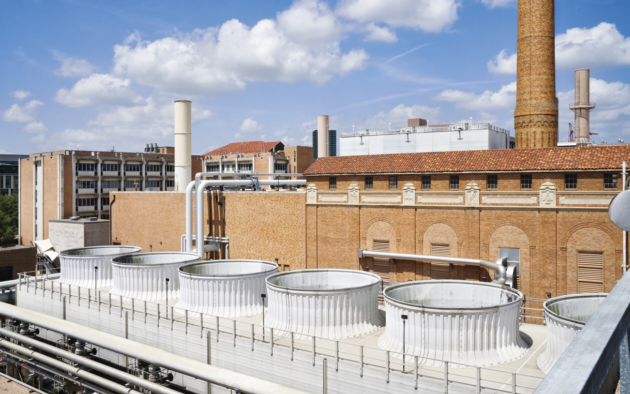
Field Trip: UT Power Plant
On April 4, 2019, law students interested in careers in energy, both domestic and international, will tour the UT Power Plant. Often described as the largest and most integrated microgrid in the U.S., the UT Austin Carl J. Eckhardt Combined Heat and Power plant (CHP) is capable of generating 135 MW (megawatt) power (63 MW peak) and 1.2 million lb/hr (pounds per hour) of steam (300,000 peak). The single largest electrical load on campus is the cooling system that can provide 60,000 tons (33,000 tons peak) of chilled water to the campus.
The Power Complex provides 100 percent of campus electricity and heating. Our five chilling stations and 9.5 million gallons of chilled water in two thermal storage tanks satisfy the cooling requirements for 17 million square foot in more than 150 campus buildings serving 70,000 faculty, students and staff. The complex provides the university with an independent utility system, with electrical ties to the City of Austin electrical grid as an emergency backup source of power.
Operating as a CHP and district energy system, the university is able to function at a much greater reliability and efficiency than that afforded through purchased energy. Typical power plants generate waste heat which is not used for electricity production and is generally expelled, either into the atmosphere through cooling towers or into local reservoirs. A CHP facility is able to convert this heat into useful work, such as space heating and hot water, thereby converting around 80 percent of the energy into useful work.
Located in the heart of campus at the corner of San Jacinto Boulevard and 24th Street, the complex is hard to miss. Walk by and you’ll see the second tallest tower on campus—the 212-foot-tall brick smokestack from the original construction. You’ll also hear the five huge water chilling stations producing what sounds like UT’s own Niagara Falls. Inside, turbines spin to produce near-deafening noise and a fair amount of external heat, making it a wonder how the workers endure. But the employees’ dedication pays off. Each year, the plant receives prestigious awards that applaud the system’s sustainability, its efficiency, and its innovative construction and design. In 2014, UT became the first campus to be Performance Excellence in Electricity Renewal (PEER) certified, which recognized its sustainable electricity system design.
Here’s how it works: The plant uses purchased natural gas (around $17 million’s worth each year) to create its utilities. It begins by powering one of two jet-engine turbines to produce the electricity that travels throughout campus to more than 160 buildings. Steam yielded from this process helps run steam turbines, and leftover exhaust steam is piped through 9 miles of underground tunnels to heat buildings and water. As for the cooling, the system has five chilling stations that create cold water to pipe through and cool down buildings. The system also recaptures water byproduct and reuses it, creating a cycle where Ontiveros says he “takes the waste and puts it back to work.”
UT has been doing all this since the 1930s, continuously improving the process and keeping up with an ever-expanding Forty Acres by finding new ways to be more efficient, cost-effective, and eco-friendly. Recently, more and more universities have taken a cue from UT and have started to develop their own campus microgrids in an effort to “control their own destiny,” as Webber says. With an increase in severe weather, such as hurricanes, the ability of campuses to stay online is crucial, especially to protect research. Ontiveros says there are about 100 universities that have some sort of power generation for their campus, but UT stands out as the only one to produce 100 percent of its energy needs.

